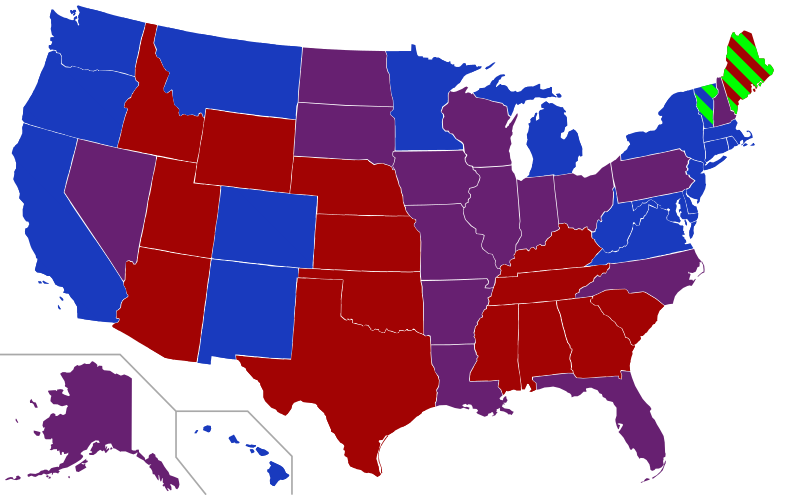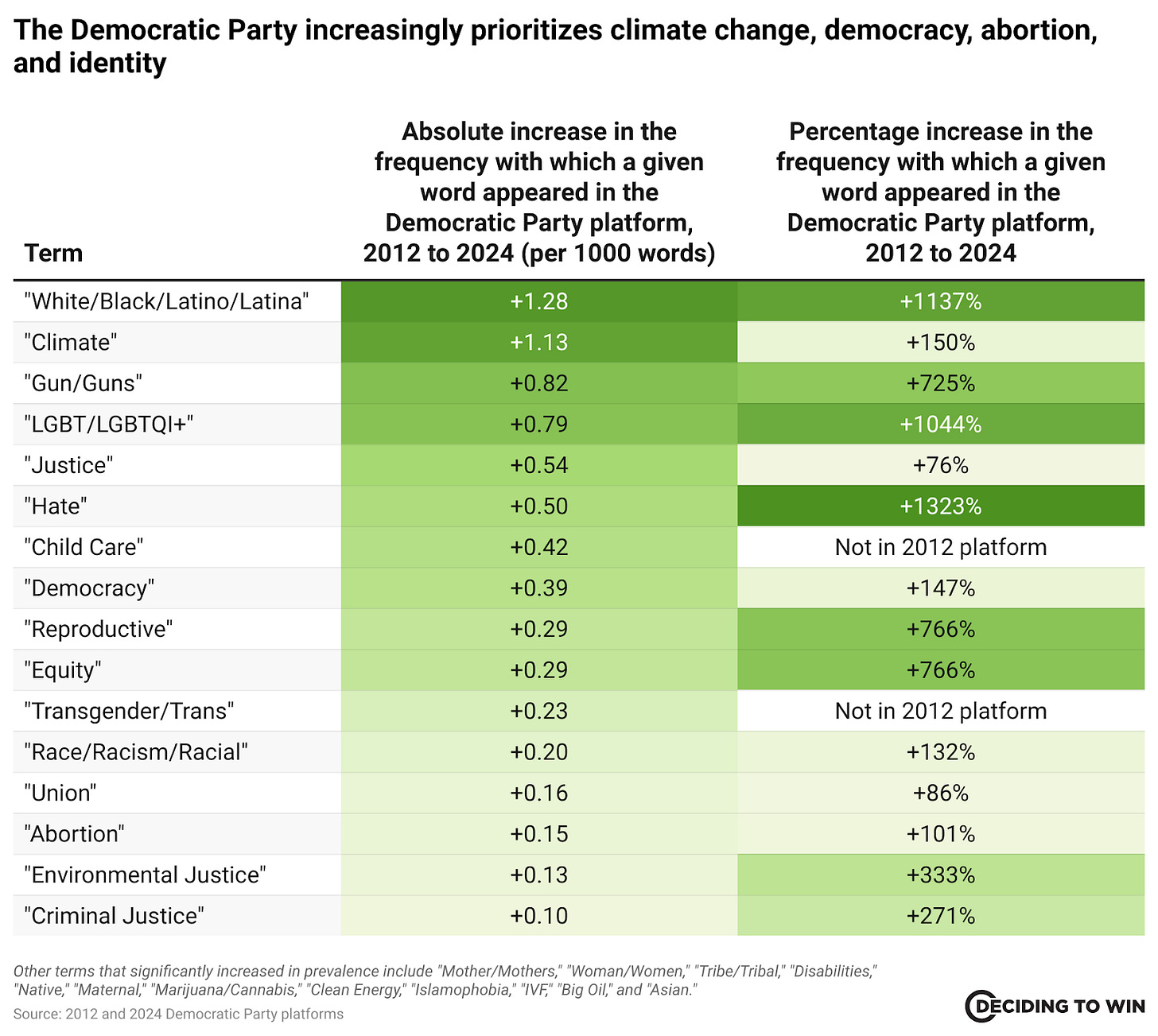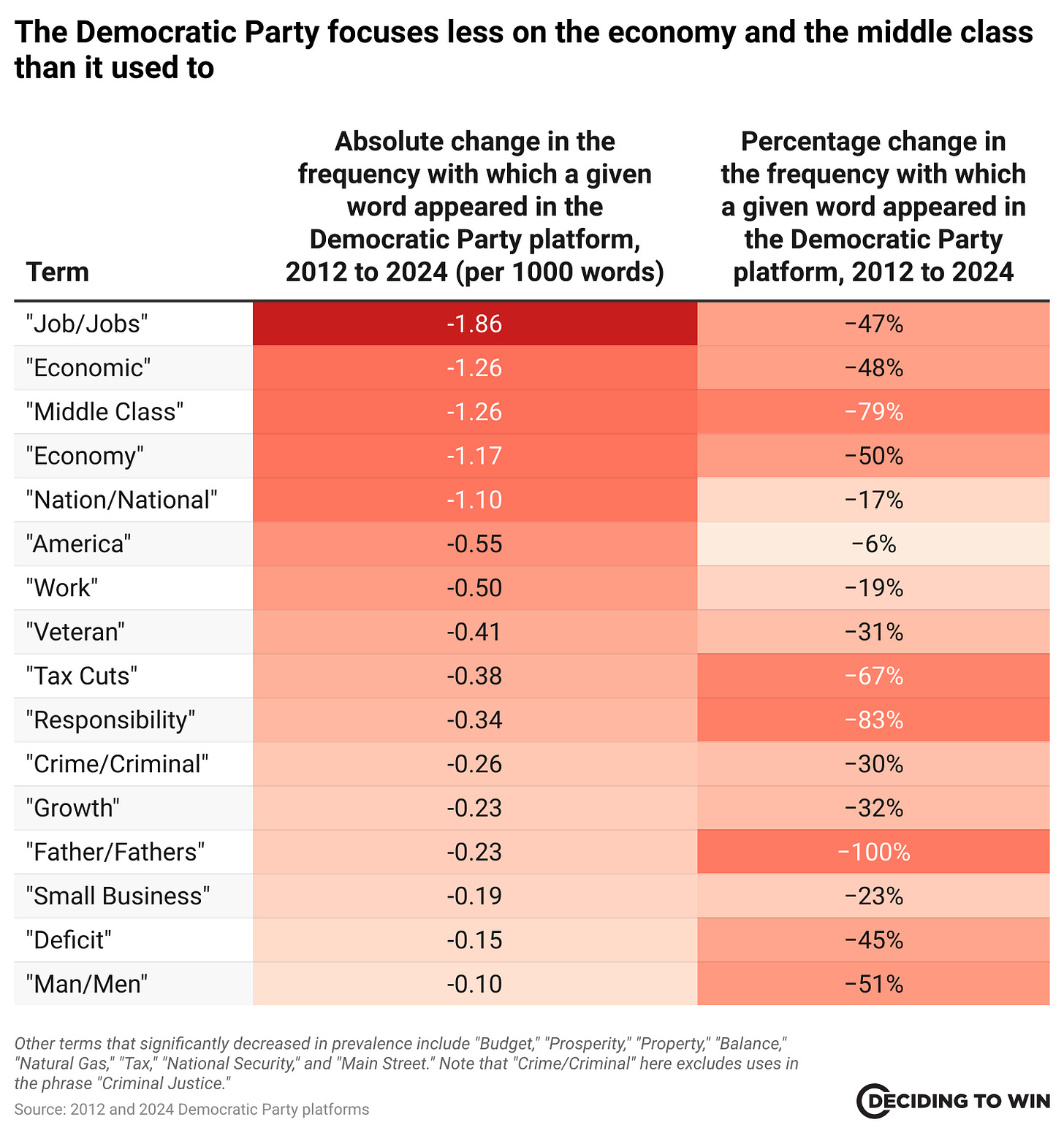I've Analyzed Democrats' Rhetoric. Here's How They Can Win
Last night's victories mask deeper failings.

The map below shows the state of the U.S. Senate after the 2012 election: a blue state indicates both of the state’s senators are Democrats, a red state indicates both are Republicans, and a purple state means there’s one senator from each party.1
Notice anything interesting about this map?
As a result of the 2012 election, a whopping 16 states had both a Democratic and a Republican U.S. senator.
As of 2025, only two states have representation from both parties.2
In what seems impossible in the 2025 context, Democrats remarkably held both Senate seats in Montana and West Virginia. They held one of the two Senate seats in Louisiana, South Dakota, Indiana, North Dakota, and Florida.
This isn’t ancient American history—it was the reality of our political environment just about a decade ago.
Meanwhile, in 2025, pundits warn of a permanent Republican majority in the Senate.
Yes, the Democrats had a strong night last night with wins in Virginia’s and New Jersey’s gubernatorial races and in down-ballot races across the country, but those are a handful of elections in an off-cycle year and do not dent the Republicans’ dominance in the middle of the country and particularly in the Senate. Across the country, Republicans have been dominating in U.S. Senate elections not only in traditionally red states but also in rural states with smaller populations like Wyoming, North Dakota, and South Dakota due to their support among non-college voters who make up majorities in those populations. Because every state sends two senators to Congress no matter the size of the state, Democrats winning these smaller population states could lead to an advantage in the Senate.
As you see in the 2012 map, Democrats used to be able to win in those states. But the party’s transformation is keeping Democrats from being competitive in places where they once had trust among voters.
The cause of that transformation is simple: Since 2012, the Democratic Party shifted from being a blue collar, working and middle class-focused coalition to a party heavily prioritizing grievance and identity politics, extreme purity tests, and issues that mattered least to voters.
In 2012, the Democratic Party platform focused relentlessly on jobs and the middle class. Obama’s message? Rebuild the economy from the middle out, not the top down. Obama and his allies centered attacks on Mitt Romney’s approach to entitlement programs and his treatment of workers.
On issues like immigration, Obama often broke with progressive immigration advocates, and millions of illegal immigrants were deported during his tenure. At the time, this marked a record high for deportations in U.S. history, earning Obama the nickname “Deporter-in-Chief” from progressive critics.
Obama’s approach was reflected in the party’s platform—a symbolic document, but one that gives clues about the party’s priorities.
The 2012 Democratic Party platform led with:
Four years ago, Democrats, independents, and many Republicans came together as Americans to move our country forward. We were in the midst of the greatest economic crisis since the Great Depression, the previous administration had put two wars on our nation’s credit card, and the American Dream had slipped out of reach for too many.
Today, our economy is growing again, al-Qaeda is weaker than at any point since 9/11, and our manufacturing sector is growing for the first time in more than a decade. But there is more we need to do, and so we come together again to continue what we started. We gather to reclaim the basic bargain that built the largest middle class and the most prosperous nation on Earth—the simple principle that in America, hard work should pay off, responsibility should be rewarded, and each one of us should be able to go as far as our talent and drive take us.
Not only did the platform lead with an emphasis on the importance of bipartisan collaboration, Democrats bragged about their national security prowess and their commitment to the actualization of the American Dream for every worker.
2012 Democrats were focused on the middle class, and they used phrases like “hard work” and “responsibility.” Democrats even acknowledge that those who demonstrate more talent and work harder may get ahead, and that’s okay.
These shifts in how Democrats think and what they prioritize are evidenced in the 2024 platform, which leads not with a message on the state of the nation, economy, or (their favorite word) democracy, but with a land acknowledgement.
The 2024 Democratic Party platform led with:
The Democratic National Committee wishes to acknowledge that we gather together to state our values on lands that have been stewarded through many centuries by the ancestors and descendants of Tribal Nations who have been here since time immemorial. We honor the communities native to this continent, and recognize that our country was built on Indigenous homelands. We pay our respects to the millions of Indigenous people throughout history who have protected our lands, waters, and animals.
You have to read down to the fifth paragraph of the 2024 platform to get to the first policy-substantive lines of text, which reads:
Our nation is at an inflection point. What kind of America will we be? A land of more freedom, or less freedom? More rights or fewer? An economy rigged for the rich and powerful, or where everyone has a fair shot at getting ahead? Will we lower the temperature in our politics and come together, or treat each other as enemies instead?
The section headers in the 2012 party platform also stand out: “Rebuilding Middle Class Security,” “Cutting Waste, Reducing the Deficit, Asking All to Pay Their Fair Share,” “21st Century Government: Transparent and Accountable,” and “Ensuring Safety and Quality of Life.”
Deficit reduction didn’t garner a section heading in 2024, but “Tackling the Climate Crisis” did.
To prove we’re not cherry-picking, Welcome—an organization dedicated to “a common-sense renewal of the Democratic Party”—in its Deciding to Win ran a comprehensive analysis of every word in the platform, and the changes are illustrative. We draw on thousands of election results, hundreds of public polls and academic papers, dozens of case studies, and surveys of more than 500,000 voters we conducted since the 2024 election.
If you compare the full text of the 2012 and 2024 Democratic Party platforms, words that increased in use the most were: Black, White, Latino/Latina, climate, LGTBQ, transgender, and environmental justice.
The words that decreased in use the most between 2012 and 2024? Economy, jobs, middle class, men, crime, fathers, and tax cuts.
And it’s not just the emphasis and language that has changed since 2012. Here’s how Democrats talked about deportation in their 2012 platform:
The Department of Homeland Security is prioritizing the deportation of criminals who endanger our communities over the deportation of immigrants who do not pose a threat, such as children who came here through no fault of their own and are pursuing an education.
In 2012, Democrats were distinguishing themselves from Republicans based on who Democrats deport: criminals versus immigrants who don’t pose a threat.
But here’s how Democrats addressed deportation in 2024:
President Biden has also taken steps to preserve and expand Temporary Protected Status (TPS) for individuals from countries experiencing armed conflicts, natural disasters, or other crises, giving thousands authorization to live and work in the United States without fear of deportation for a temporary period.
In 2024, Democrats distinguished themselves from Republicans based on their willingness to deport people at all.
And voters noticed.
The result of moves like this is shown in the chart below: Democrats are increasingly (correctly) perceived as more liberal. The chart shows the share of voters who describe Democrats as “too liberal” in all the polls that asked the question. Democrats increased from around 45% of voters calling them “too liberal” to more than 55%, a massive shift in an era when elections are normally decided by less than 3% of the vote.
The platform changes are also reflected in what voters perceive Democrats to be prioritizing.
While voters want to see Democrats prioritize cost of living, middle class issues, and healthcare, they believe Democrats are focused on protecting illegal immigrants, LGBTQ issues, and raising their taxes.
The chart below shows what voters say they want Democrats to prioritize: Social Security, Medicare, and costs.
The next chart shows the gap between what voters want Democrats to prioritize and what they perceive Democrats to be prioritizing. A positive number indicates that voters believe Democrats prioritize the issue too much, while a negative number means it’s prioritized too little.
The chart shows voters believe Democrats are not sufficiently prioritizing issues like securing the border, lowering prices, and addressing crime. On the other hand, voters believe Democrats prioritize the rights of illegal immigrants, LGBTQ rights, and raising taxes too much.
The natural question here is obvious: why have Democrats made this dramatic shift to the left? The 2012 Democratic platform worked to reflect the views of the average American. And if you asked the average modern Democratic voter if they believed the 2012 platform was too conservative on immigration, few would.
Democrats’ shift to the left hasn’t been driven by voters. In 2012, 22% of voters self-identified as liberal, which is not far from the 25% who do today.
Instead, Democrats have shifted left from the 2012 platform to the 2024 platform because the Democratic party has been overtaken by an activist class that works to advance the priorities of progressives—not the sentiments of the median voter. Rhetorically, Democrats have also participated in the politics of evasion by not specifically articulating what they believe or don’t believe when it comes to the issues.
If you think back to the successful coalition of 2012, winning means turning down the volume of (and tuning out) activists and staffers to instead focus on what the voters believe.
It means substantively, authentically differentiating the Democratic Party brand. It means having the courage to say what you believe about issues like immigration, abortion, transgender athletes, domestic oil production, and crime, and prioritizing local issues to align with where voters are. It means being a depolarizer, not a polarizer. It also means not being fooled by a transient result like Zohran Mamdani’s mayoral victory in New York City. The kinds of progressive issues that Mamdani leans into may work with liberal voters in a blue city, but the data suggests that they do not translate well to national politics, where 71% of voters identify as moderate or conservative and, over the past decade, have made their stances well known.
If Democrats care about this country as much as they say they do, they would respect voters enough to align with where they are on the issues.
That is deciding to win.
Lauren Harper Pope is a Welcome co-founder focusing on effective political depolarization and centrist faction-building on the left. Lauren lives in South Carolina and is an alumna of the University of South Carolina.
Follow Persuasion on Twitter, LinkedIn, and YouTube to keep up with our latest articles, podcasts, and events, as well as updates from excellent writers across our network.
And, to receive pieces like this in your inbox and support our work, subscribe below:
The green indicates an independent senator who caucuses with Democrats.
Maine has a Republican (Susan Collins) and an independent who caucuses with Democrats (Angus King) in the U.S. Senate.










Y’all have lost your minds. Each of the candidates for Governor of New Jersey, Virginia and Mayor of NYC centered their campaigns around the affordability crisis, speaks to the center, and all won by huge majorities. The majorities were so large that most people who would be considered in the center voted for these candidates. Look also at other votes around the country like the Supreme court vote in PA - the Dems won 61% and some of the referendums around the country and local elections, as well. Look , I agree there is too much polarization, but y’all are simply wrong about the Democratic Party or misjudging it. Don’t just fall in line for conventional wisdom, opposition talking points, lack of insightful or shoddy research, easy answers, and conventional wisdom.
I not sure about the general voter, but this sounds so much better than what we have. I disliked Trump, voted for Harris, and still dislike Trump. However, in many ways I'm glad he won, even though I wish he was gone now. Trump did some good with his anti-DEI initiatives and his foreign policy that Harris never would have, even if I have serious criticisms of some of his Trump's methods.